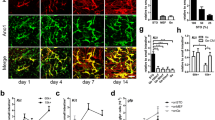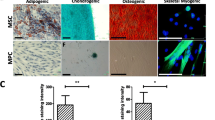Summary
BACKGROUND: Esophagus tissue engineering using the hybrid-construct approach involves assembly of the esophageal components to engineer the organ. This study investigated the dedifferentiation and loss in expression of esophageal smooth muscle after explant expansion in culture. METHODS: Ovine esophagus smooth muscle cells (OESMC) were sourced from adult biopsies and expanded using the explant culture technique. The explants were maintained under static in vitro tissue culture. Flow cytometry analysis was performed for α-smooth muscle actin (α-SMA) expression at intervals of 4 weeks for up to 8 weeks. RESULTS: After 4 weeks 58.5% OESMC exhibited α-SMA which decreased to 28.5% after 6 weeks in culture. After 8 weeks in culture a mere 1.3% OESMC demonstrated α-SMA expression. CONCLUSIONS: OESMC proliferated using the explant technique exhibit a total loss of α-SMA expression after 8 weeks of static in vitro culture. This information is crucial for tissue engineering of the esophagus using the hybrid-construct approach.
Similar content being viewed by others
References
Saxena AK. Tissue engineering: present concepts and strategies. J Indian Assoc Pediatr Surg 2005;10:14–19
Saxena AK. Congenital Anomalies of Soft Tissues: Birth Defects Depending on Tissue Engineering Solutions and Present Advances in Regenerative Medicine. Tissue Eng Part B Rev 2009: doi:10.1089/ten.teb.2009.0700
Saxena AK. Tissue engineering and regenerative medicine research perspectives for pediatric surgery. Pediatr Surg Intl 2010; 26:557–73
Riffat F, Cheng A. Pediatric caustic ingestion: 50 consecutive cases and a review of the literature. Dis Esophagus 2009;22: 89–94
Ramasamy K, Gumaste VV. Corrosive ingestion in adults. J Clin Gastroenterol 2003;37:119–24
Thomas MO, Ogunleye EO, Somefun O. Chemical injuries of the oesophagus: aetiopathological issues in Nigeria. J Cardiothorac Surg 2009;4:56
Spitz L, Ruangtrakool R. Esophageal substitution. Semin Pediatr Surg 1998;7:130–3
Cusick EL, Batchelor AA, Spicer RD. Development of a technique for jejunal interposition in long-gap esophageal atresia. J Pediatr Surg 1993;28:990–4
Raffensperger JG, Kuck SR, Reynolds M, Schwartz D. Intestinal bypass of the esophagus. J Pediatr Surg 1996;31:38–46
Spitz L. Esophageal atresia-lessons I have learned in a 40-year experience. J Pediatr Surg 2006;41:1635–40
Cauchi JA, Buick RG, Gornall P, Simms MH, Parikh DH. Oesophageal substitution with free and pedicled jejunum: short- and long-term outcomes. Pediatr Surg Intl 2007;23:11–9
Arul GS, Parikh D (2008) Oesophageal replacement in children. Ann R Coll Surg Engl 90:7–12
Kajitani M, Wadia Y, Hinds MT, Teach J, Swartz KR, Gregory KW. Successful repair of esophageal injury using an elastin based biomaterial patch. ASAIO J 2001;47:342–5
Isch JA, Engum SA, Ruble CA, Davis MM, Grosfeld JL. Patch esophagoplasty using AlloDerm as a tissue scaffold. J Pediatr Surg 2001;36:266–8
Takimoto Y, Nakamura T, Yamamoto Y, Kiyotani T, Teramachi M, Shimizu Y. The experimental replacement of a cervical esophageal segment with an artificial prosthesis with the use of collagen matrix and a silicone stent. J Thorac Cardiovasc Surg 1998;116:98–106
Badylak S, Meurling S, Chen M, Spievack A, Simmons-Byrd A. Resorbable bioscaffold for esophageal repair in a dog model. J Pediatr Surg 2000;35:1097–103
Doede T, Bondartschuk M, Joerck C, Schulze E, Goernig M. Unsuccessful alloplastic esophageal replacement with porcine small intestinal submucosa. Artif Organs 2009;33:328–33
Saxena AK, Ainoedhofer H, Höllwarth ME. Esophagus tissue engineering: in vitro generation of esophageal epithelial sheets and viability on scaffold. J Pediatr Surg 2009;44:896–901
Miki H, Ando N, Ozawa S, Sato M, Hayashi K, Kitajima M. An artificial esophagus constructed of cultured human esophageal epithelial cells, fibroblasts, polyglycolic acid mesh, and collagen. ASAIO J 1999;45:502–8
Kofler K, Leitinger G, Kristler M, Saxena AK. Smooth muscle tissue engineering for hybrid tubular organs: scanning electron microscopic investigations of cell interactions with collagen scaffolds. J Tissue Eng Regen Med 2009;3:321–4
Saxena AK, Kofler K, Ainödhofer H, Höllwarth ME. Esophagus tissue engineering: hybrid approach with esophageal epithelium and unidirectional smooth muscle tissue component generation in vitro. J Gastrointest Surg 2009;13:1037–43
Kofler K, Ainoedhofer H, Höllwarth ME, Saxena AK. Fluorescence-activated cell sorting of PCK-26 antigen-positive cells enables selection of ovine esophageal epithelial cells with improved viability on scaffolds for esophagus tissue engineering. Pediatr Surg Int 2010;26:97–104
Saxena AK, Ainoedhofer H, Höllwarth ME. Culture of ovine esophageal epithelial cells and in vitro esophagus tissue engineering. Tissue Eng Part C Methods 2010;16:109–14
Llorente-Cortés V, Otero-Viñas M, Berrozpe M, Badimon L. Intracellular lipid accumulation, low-density lipoprotein receptor-related protein expression, and cell survival in vascular smooth muscle cells derived from normal and atherosclerotic human coronaries. Eur J Clin Invest 2004;34:182–90
Wang C, Cen L, Yin S, Liu Q, Liu W, Cao Y, Cui L. A small diameter elastic blood vessel wall prepared under pulsatile conditions from polyglycolic acid mesh and smooth muscle cells differentiated from adipose-derived stem cells. Biomaterials 2010;31:621–30
Yazdani SK, Watts B, Machingal M, Jarajapu YP, Van Dyke ME, Christ GJ. Smooth muscle cell seeding of decellularized scaffolds: the importance of bioreactor preconditioning to development of a more native architecture for tissue-engineered blood vessels. Tissue Eng Part A 2009;15:827–40
Owens GK, Loeb A, Gordon D, Thompson MM. Expression of smooth muscle-specific alpha-isoactin in cultured vascular smooth muscle cells: relationship between growth and cytodifferentiation. J Cell Biol 1986;102:343–52
Grenier S, Sandig M, Mequanint K. Smooth muscle alpha-actin and calponin expression and extracellular matrix production of human coronary artery smooth muscle cells in 3D scaffolds. Tissue Eng Part A 2009;15:3001–11
Halayko AJ, Rector E, Stephens NL. Characterization of molecular determinants of smooth muscle cell heterogeneity. Can J Physiol Pharmacol 1997;75:917–29
Simpson RM, Meran S, Thomas D, Stephens P, Bowen T, Steadman R, Phillips A. Age-related changes in pericellular hyaluronan organization leads to impaired dermal fibroblast to myofibroblast differentiation. Am J Pathol 2009;175:1915–28
Braun-Dullaeus RC, Mann MJ, Sedding DG, Sherwood SW, von der Leyen HE, Dzau VJ. Cell cycle-dependent regulation of smooth muscle cell activation. Arterioscler Thromb Vasc Biol 2004;24:845–50
Adelöw C, Segura T, Hubbell JA, Frey P. The effect of enzymatically degradable poly(ethylene glycol) hydrogels on smooth muscle cell phenotype. Biomaterials 2008;29:314–26
Owens GK, Kumar MS, Wamhoff BR. Molecular regulation of vascular smooth muscle cell differentiation in development and disease. Physiol Rev 2004;84:767–801
Li S, Sims S, Jiao Y, Chow LH, Pickering JG. Evidence from a novel human cell clone that adult vascular Smooth Muscle Cells can convert reversibly between noncontractile and contractile phenotypes. Circ Res 1999;85:338–48
Thyberg J, Hedin U, Sjolund M, Palmberg L, Bottger BA. Regulation of differentiated properties and proliferation of arterial smooth muscle cells. Atherosclerosis 1990;63:99–107
Chen HC, Hu YC. Bioreactors for tissue engineering. Biotechnol Lett 2006;28:1415–23
Takahashi Y, Imanaka T, Takano T. Spatial pattern of smooth muscle differentiation is specified by the epithelium in the stomach of mouse embryo. Dev Dyn 1998;212:448–60
Rose SL, Babensee JE. Complimentary endothelial cell/smooth muscle cell co-culture systems with alternate smooth muscle cell phenotypes. Ann Biomed Eng 2007;35:1382–90
Author information
Authors and Affiliations
Corresponding author
Rights and permissions
About this article
Cite this article
Kofler, K., Ainoedhofer, H., Tausendschön, J. et al. Esophageal smooth muscle cells dedifferentiate with loss of α-smooth muscle actin expression after 8 weeks of explant expansion in vitro culture: Implications on esophagus tissue engineering. Eur Surg 43, 168–173 (2011). https://doi.org/10.1007/s10353-011-0617-7
Received:
Accepted:
Issue Date:
DOI: https://doi.org/10.1007/s10353-011-0617-7




